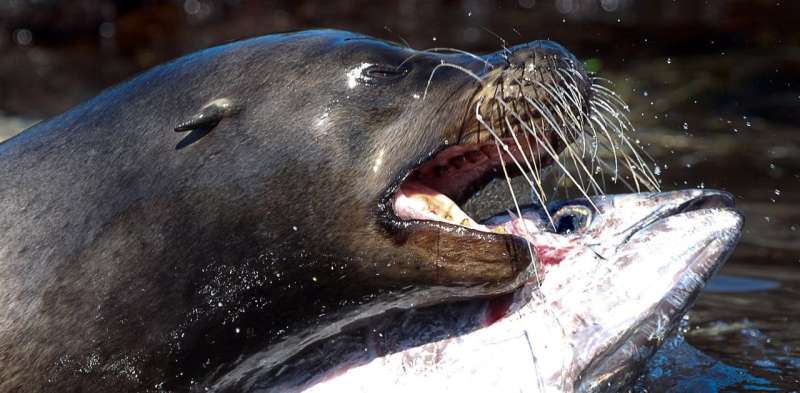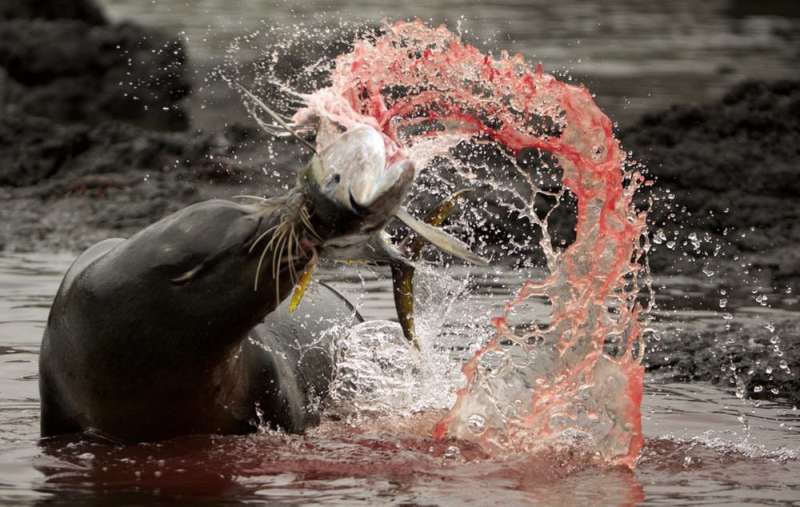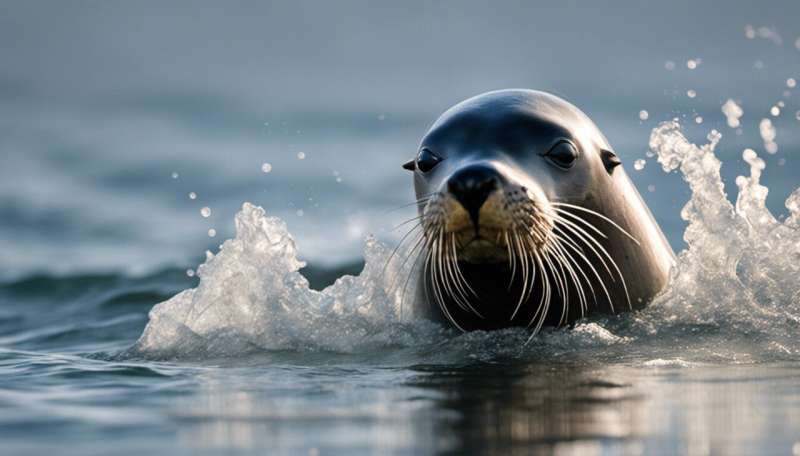Credit: BBC NHU 2017/Rachel Butler
Astounding footage of Galapagos sea lions hunting was perhaps the highlight of the latest Blue Planet II. For the first time ever, these marine mammals were filmed working as a pack to drive tuna fish in to shallow, rocky waters where they could be caught. Yellowfin tuna are typically able to outswim all predators but the fastest sharks and marlins, yet the much slower sea lions were able to outsmart them thanks to an amazing display of movement and cooperation.
I've studied these animals for years as I'm fascinated by their remarkable whiskers. So what is it about sea lions that makes them such excellent hunters? Here are three of their key adaptations:
Superb sensing
One of the things you can see clearly in the Blue Planet II footage is just how quickly the sea lions respond to the movements of the fish. They are able to sense exactly where the fish are and react almost instantly, in order to herd them towards shallow waters.
Sea lions have amazing senses that allow them to detect fish, even in murky underwater environments. Like many predators, their eyes point forward so that they can easily focus on their prey. They can also open their pupils really wide to let lots of light in to their eye which helps them to see clearly underwater.
Demanding foresight, planning and cooperation, this clever fishing technique has only ever been seen in the Galapagos #BluePlanet2 pic.twitter.com/HPw5CNifLB
— BBC Earth (@BBCEarth) December 3, 2017
However, sea lions aren't always blessed with the clear waters of the Galapagos coastline. In really murky environments, sometimes vision is just not good enough. For this reason, sea lions primarily rely on their sense of touch, using their super-sensitive whiskers to feel exactly where the fish are in the water. When fish swim around they leave little waves, or wakes, behind them. Sea lions are able to detect these wakes and follow them, just by using their whiskers.
Messy eater. Credit: Richard Wollocombe / BBC
Most mammals have facial whiskers (humans are unusual in that regard) which, when cut in cross-section, are circular. But sea lion whiskers are oval. Research has shown this is the best shape to sense the speed and direction of the wakes while minimising the vibrating "noise" created by the sea lion's own swimming.
At around 30cm, these are the longest whiskers of all mammals. They can move them backwards and forwards. Much like we use our finger tips for touch, sea lions can sweep their whiskers over objects to feel their size, shape and texture. These same skills mean those in the wild can find the biggest and tastiest fish, just by touching them with their whiskers.
Today our sea lions learnt to distinguish between three textures using just their whiskers! Well done girls and fab job @MissAlyxMilne! @MMU_CEB @MMUsste @BlackpoolZoo pic.twitter.com/8PCHMrNxmE
— Robyn Grant (@RobynAnneGrant) October 6, 2017
Sea lions communicate using various "barks", grunts and growls, especially when they are hunting as a group. They have ears that are able to pick up sounds both above and below water. However, their ears are very small, so they can still be super streamlined in the water.
Quick moving
This streamlining means the sea lions are able to move quickly and efficiently through the water. Front flippers are used to push themselves along, while back flippers are used for steering. They're able to chase fish at speeds of around 25mph but are flexible enough to quickly change direction.
Credit: AI-generated image (disclaimer)
Sea lions use their whiskers to guide these fast changes in direction. For example, captive sea lions who have learned to balance balls on their noses have been shown to move their whiskers ahead of their heads to sense and control the ball. During swimming, they use their whiskers in a similar way and move their whiskers ahead of a full turn, so the whiskers are constantly scanning the space that the head and body are about to move in to. This also means that the whiskers constantly face towards the fish that the sea lion is trying to catch.
Clever cognition
As well as their amazing sensing abilities and quick movements, sea lions are also very clever and display many behaviours that we often only associate with humans. For instance, they are one of the only animals able to bob their heads along to a piece of music. They are also very quick to learn new behaviours, which is why they are so common to see in zoo and aquarium displays.
Indeed, the group hunting footage, shows the sea lions are not simply reacting to the fish, but acting out a complex series of well thought out behaviours.
Hunting together can increase the chances of getting more prey when there are large groups of fish. Usually sea lions hunt together by herding fish in to tight balls and picking off the individuals around the edges. Sea lions seem to know when it is good to hunt together, and usually do so when prey is abundant. They tend to hunt individually when prey is scarce.
The remarkable footage from Blue Planet II really reveals what fantastic predators sea lions are. Their whisker-sensing strategies, quick acrobatic movements, and clever cognitive abilities make them ideally suited to hunting speedy fish like tuna.
Provided by The Conversation
This article was originally published on The Conversation. Read the original article.![]()

























